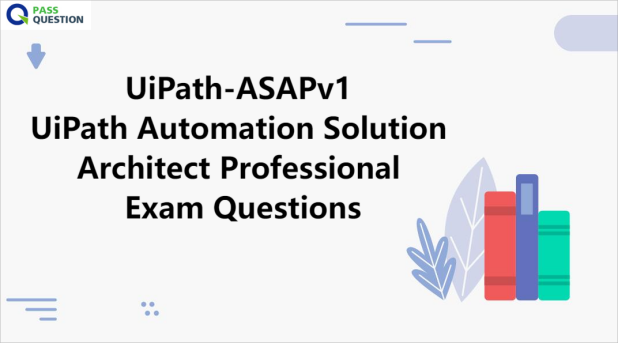UiPath-ASAPv1 UiPath Automation Solution Architect Professional Exam Questions
Are you prepared to embark on the journey of taking the UiPath-ASAPv1 UiPath Certified Professional Automation Solution Architect Professional exam? PassQuestion is here to provide you with the most recent UiPath-ASAPv1 UiPath Automation Solution Architect Professional Exam Questions. These questions are the embodiment of the real, valid, and constantly updated UiPath-ASAPv1 exam questions that will be your trustworthy companions in your exam preparation journey. Equipped with these UiPath-ASAPv1 UiPath Automation Solution Architect Professional Exam Questions, you will surely be able to conquer the upcoming UiPath-ASAPv1 exam with flying colors, opening up a world of opportunities for your future.

UiPath Certified Professional Automation Solution Architect Professional v1.0
UiPath Certified Professional Automation Solution Architect Professional is expected to have an extensive knowledge in architecture and technology stack of automation as well as hands-on experience with automating complex business processes. Automation Solution Architect Professional Certification is targeted to assess the skills required to play a critical role in analyzing, designing, developing, testing, and operationalizing automation solutions using UiPath products.
UiPath Certified Professional Automation Solution Architect Professional is a credential that represents an advanced level of expertise in UiPath Automation Implementation Methodology and is suitable for roles such as Advanced Automation Developers, Solution Architects, Automation Architects, and others.
Prerequisite: To be eligible for Automation Solution Architect Professional certification, at least one of the following certifications is required:
• Automation Developer Professional
• Advanced RPA Developer (UiARD)
Target Audience
The target audience for the UiPath Automation Solution Architect Professional v1.0 Exam includes:
• Automation Architects, Solution Architects, Technical Architects
• Roles requiring advanced Automation Developer expertise such as Solution Designers, Automation Engineers, etc.
Exam Details
Certification: Track UiPath Certified Professional – Solution Architect Track
Credential: UiPath Certified Professional Automation Solution Architect Professional v1.0
Valid Period: 3 years
Exam Number and Exam Title: UiPath-ASAPv1 - UiPath Automation Solution Architect Professional v1.0 Exam
Pre-requisite Exam(s) and/or Certification(s): UiPath Certified Professional Automation Developer Professional or UiPath Certified Professional Advanced RPA Developer. UiPath RPA Developer Advanced certification obtained through our legacy program does not meet this prerequisite.
Exam Duration: 120 minutes
Passing Score: 70%
Exam Fee: $300
Exam Domains/Exam Sections
The Automation Solution Architect Professional v1.0 Exam contains the following exam sections:
• UiPath Products Architecture
• UiPath Deployment Options
• Unified Platform Management
• UiPath Data Service
• UiPath Apps
• UiPath Action Center
• Document Understanding Process
• UiPath Document Understanding
• UiPath AI Center
• Attended Automation Framework
• UiPath Automation Ops
• UiPath Test Manager
• UiPath Process Mining
• UiPath Task Mining
• UiPath Communications Mining
• UiPath Automation Hub
• UiPath Solution Accelerator
• Implementation Methodology Fundamentals
• Business Case and Technical Validation
• Process Analysis
• Solution Design
• Development and Testing
• UAT
• Hands On Experience
View Online UiPath Automation Solution Architect Professional UiPath-ASAPv1 Free Questions
1. What can be stated as factual when it comes to deploying and executing in Service Mode?
A.Has the rights of the user that runs it.
B.The Service Mode Robot is best suited to attended automation scenarios.
C.Requires a user to be logged in with an active session to execute jobs from Orchestrator.
D.Can execute jobs from Orchestrator even if a user is not logged in by starting a session.
Answer: D
2. What role provides developers with the details for code repository requirements?
A.Solution Architect
B.Project Manager
C.Program Manager
D.Client IT Owner
Answer: A
3. What are two key best practices for UiPath license estimation?
A.Assess the number and complexity of processes and identify required robot types (such as Attended or Unattended).
B.Calculate the ROI of automating a certain process and assess the volume of emails processed by the automations.
C.Analyze business metrics and identify the number of applications automated by the processes.
D.Assess concurrent robot usage during peak workload and optimize the chain of approvals in the decision-making.
Answer: A, D
4. What is the main purpose of Workflow Analyzer in UiPath Studio?
A.Downloading external packages and resolving dependencies for a project.
B.Creating a visual flowchart that represents the logic of the workflow for easy understanding.
C.Evaluating best-practices usage in the process, identifying design errors and areas for improvement.
D.Debugging and executing the workflow step-by-step to track any errors.
Answer: C
5. What is a requirement to access Automation Cloud?
A.Need a dedicated infrastructure
B.Need a compatible browser
C.Need to install on-premises
D.Need an offline access
Answer: B
6. Which of the following phases are part of the UiPath Automation Hub lifecycle?
A.Idea Qualification Assessment
B.Analysis Solution Design Tasks Documentation
C.Qualification, Development Process Map
D.Assessment Data Gathering Testing
Answer: A
7. What type of applications can be built using UiPath Apps?
A.Application focused on Integrating and managing UiPath RPA automations
B.Applications primarily targeting data analyse and machine learning
C.Simple applications with base user interaction and limited functionality
D.Custom business applications tor data access and complex business log*:
Answer: D
8. When elements of UiPath Automaton Platform are best suited for managing long-running activities in RPA projects?
A.Queues tasks jobs
B.Libraries assets triggers
C.Tenants packages webhooks
D.Folders, entities permissions
Answer: D
9. What is a layer that is redundant for a Solution Architect to take into account when designing the Reusable Components for a project?
A.Logic layer
B.Persistence layer (saving data)
C.Process steps that are not part of the User Interlace interaction layer or the Logic layer or the Persistence layer
D.User interface interaction layer (interact with applications)
Answer: C
10. Which of the Mowing can be achieved by using Automaton Ops?
A.Define the licensing availability and strategy
B.Preform remote installations of UPath products (Such as Studio Assistant)
C.Configure connection between different products inside the UiPath ecosystem
D.Configure and deploy governance policies
Answer: D
- TOP 50 Exam Questions
-
Exam
All copyrights reserved 2025 PassQuestion NETWORK CO.,LIMITED. All Rights Reserved.

